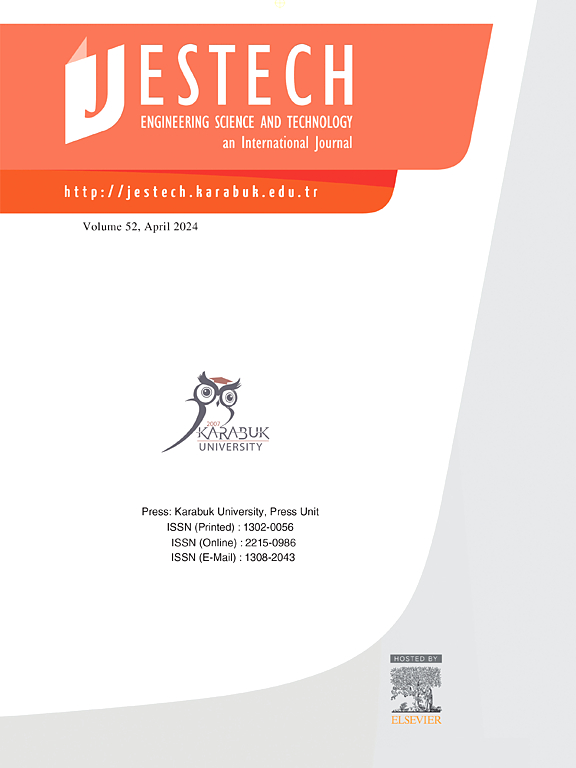A circularly polarized metantenna for 5G and RF energy harvesting applications
IF 5.4
2区 工程技术
Q1 ENGINEERING, MULTIDISCIPLINARY
Engineering Science and Technology-An International Journal-Jestech
Pub Date : 2025-07-03
DOI:10.1016/j.jestch.2025.102124
引用次数: 0
Abstract
We present a broadened, circularly polarized, high-gain surrogate model-assisted differential evolution for antenna synthesis (SADEA)-driven metantenna to fulfill the necessity of 5G communication applications at a sub-6 GHz. Initially, we consider a linearly polarized (LP) printed monopole antenna at Stage 1. To attain circular polarization (CP), a metallic strip is utilized as the dynamic switching mechanism to connect one of the parasitic conducting strips to a partial ground plane and short it out. So, this particular geometry expands upon Stages 2 and 3, proposing a straightforward mechanism to transition from LP to CP. In Stage 4, the objective is to make it a suitable candidate for RF energy harvesting, which is a bigger part of the 5G communication applications. Hence, from the application perspective, we achieve the performance trade-offs by increasing the CP gain, impedance (10-dB BW), and axial bandwidth (3-dB BW). This is achieved by placing the SADEA-tuned metasurface layer at a height of 0.33 , is directly beneath the CP monopole radiator. Stage 4 is fabricated on an FR-4 substrate and offers a measured 46.41% 10-dB BW, 18.42% 3-dB BW, a peak CP antenna gain of 8.35 dBic, and an antenna efficiency of 75% in the desired operating band. These outcomes are beneficial for technical applications in wireless technology, ensuring the stability of RF networks through the incorporation of smart metasurfaces. Their usage provides individualized, efficient, and typical management of EM waves in accordance with the ambient RF conditions of the desired bands, bringing about an exemplary shift in a wireless communication environment in response to ever-increasing requirements.
一种用于5G和射频能量收集应用的圆极化元天线
我们提出了一种扩宽、圆极化、高增益替代模型辅助差分进化的天线合成(SADEA)驱动的元天线,以满足低于6 GHz的5G通信应用的需要。最初,我们在阶段1考虑线性极化(LP)印刷单极天线。为了获得圆极化(CP),利用金属带作为动态开关机构将寄生导电带连接到部分地平面并将其短路。因此,这种特殊的几何形状扩展了阶段2和3,提出了一种从LP过渡到CP的直接机制。在阶段4中,目标是使其成为射频能量收集的合适候选者,这是5G通信应用中更大的一部分。因此,从应用的角度来看,我们通过增加CP增益、阻抗(10 db BW)和轴向带宽(3 db BW)来实现性能折衷。这是通过将经saea调谐的超表面层置于0.33λ°的高度来实现的,该超表面层就在CP单极辐射器的正下方。Stage 4在FR-4衬底上制造,提供46.41%的10 db BW和18.42%的3 db BW,峰值CP天线增益为>;8.35 dBic,天线效率为;75%在所需的工作频带。这些结果有利于无线技术的技术应用,通过集成智能元表面来确保RF网络的稳定性。它们的使用可根据所需频段的环境射频条件提供个性化、高效和典型的电磁波管理,从而在无线通信环境中实现典型的转变,以响应不断增长的需求。
本文章由计算机程序翻译,如有差异,请以英文原文为准。
求助全文
约1分钟内获得全文
求助全文
来源期刊

Engineering Science and Technology-An International Journal-Jestech
Materials Science-Electronic, Optical and Magnetic Materials
CiteScore
11.20
自引率
3.50%
发文量
153
审稿时长
22 days
期刊介绍:
Engineering Science and Technology, an International Journal (JESTECH) (formerly Technology), a peer-reviewed quarterly engineering journal, publishes both theoretical and experimental high quality papers of permanent interest, not previously published in journals, in the field of engineering and applied science which aims to promote the theory and practice of technology and engineering. In addition to peer-reviewed original research papers, the Editorial Board welcomes original research reports, state-of-the-art reviews and communications in the broadly defined field of engineering science and technology.
The scope of JESTECH includes a wide spectrum of subjects including:
-Electrical/Electronics and Computer Engineering (Biomedical Engineering and Instrumentation; Coding, Cryptography, and Information Protection; Communications, Networks, Mobile Computing and Distributed Systems; Compilers and Operating Systems; Computer Architecture, Parallel Processing, and Dependability; Computer Vision and Robotics; Control Theory; Electromagnetic Waves, Microwave Techniques and Antennas; Embedded Systems; Integrated Circuits, VLSI Design, Testing, and CAD; Microelectromechanical Systems; Microelectronics, and Electronic Devices and Circuits; Power, Energy and Energy Conversion Systems; Signal, Image, and Speech Processing)
-Mechanical and Civil Engineering (Automotive Technologies; Biomechanics; Construction Materials; Design and Manufacturing; Dynamics and Control; Energy Generation, Utilization, Conversion, and Storage; Fluid Mechanics and Hydraulics; Heat and Mass Transfer; Micro-Nano Sciences; Renewable and Sustainable Energy Technologies; Robotics and Mechatronics; Solid Mechanics and Structure; Thermal Sciences)
-Metallurgical and Materials Engineering (Advanced Materials Science; Biomaterials; Ceramic and Inorgnanic Materials; Electronic-Magnetic Materials; Energy and Environment; Materials Characterizastion; Metallurgy; Polymers and Nanocomposites)
 求助内容:
求助内容: 应助结果提醒方式:
应助结果提醒方式:


